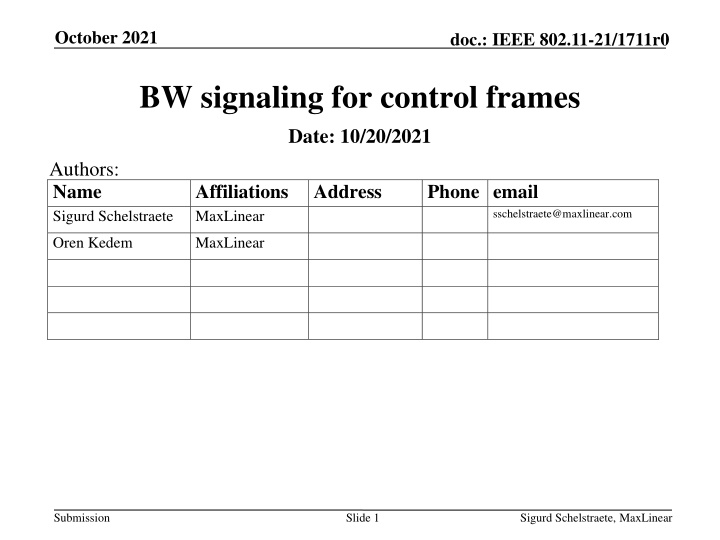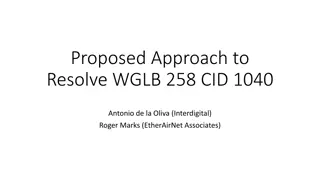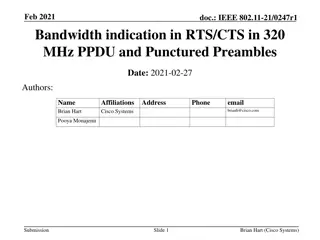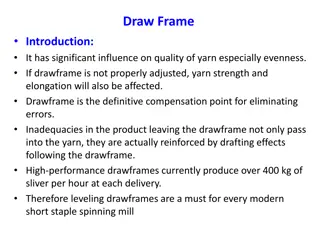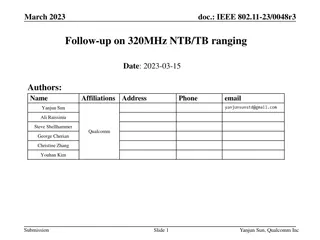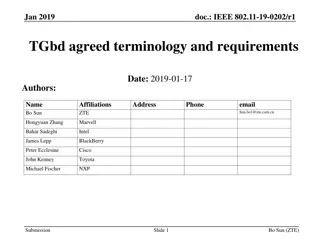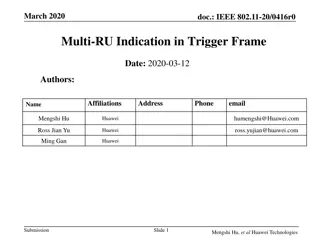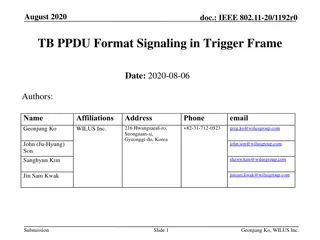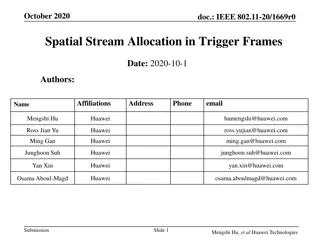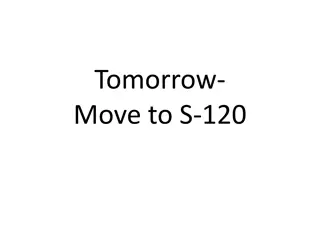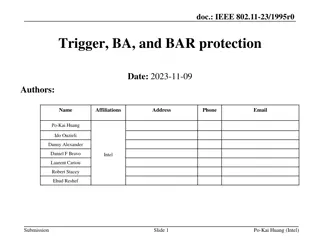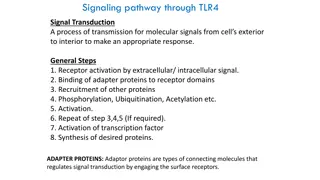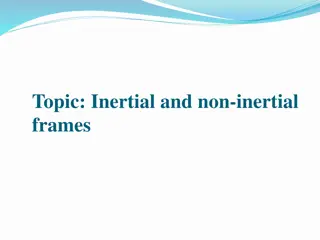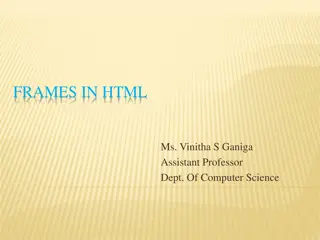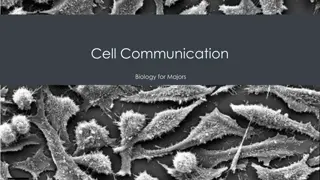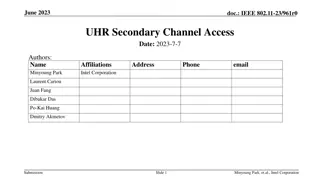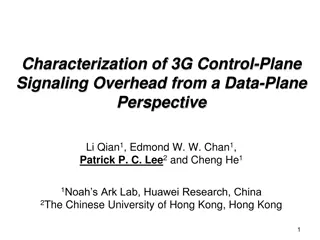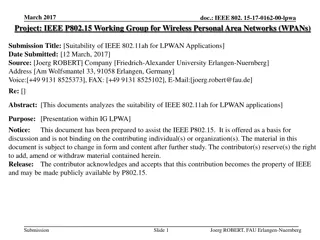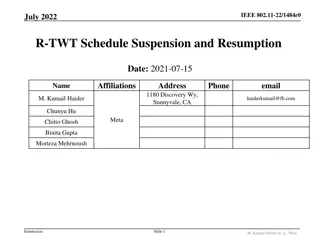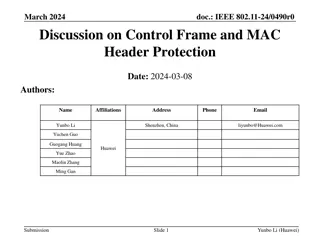IEEE 802.11-21/1711r0 BW Signaling for Control Frames
Introduction to IEEE 802.11-21/1711r0 discussing BW signaling for control frames in Wi-Fi networks. Highlights include the purpose, unconventional signaling methods, benefits of non-HT duplicate format, and the need for future-proof mechanisms.
Download Presentation

Please find below an Image/Link to download the presentation.
The content on the website is provided AS IS for your information and personal use only. It may not be sold, licensed, or shared on other websites without obtaining consent from the author.If you encounter any issues during the download, it is possible that the publisher has removed the file from their server.
You are allowed to download the files provided on this website for personal or commercial use, subject to the condition that they are used lawfully. All files are the property of their respective owners.
The content on the website is provided AS IS for your information and personal use only. It may not be sold, licensed, or shared on other websites without obtaining consent from the author.
E N D
Presentation Transcript
October 2021 doc.: IEEE 802.11-21/1711r0 BW signaling for control frames Date: 10/20/2021 Authors: Name Sigurd Schelstraete Affiliations MaxLinear Address Phone email sschelstraete@maxlinear.com Oren Kedem MaxLinear Submission Slide 1 Sigurd Schelstraete, MaxLinear
October 2021 doc.: IEEE 802.11-21/1711r0 Introduction 11ac introduced BW signaling for Control frames sent in non-HT duplicate format Purpose: provide explicit BW information that can not be carried natively in non-HT duplicate, such as: Occupied BW Support of dynamic BW RTS/CTS negotiation To pre-11ac devices, the frames still looks like ordinary non-HT For compatibility with legacy devices, the signaling is somewhat unconventional : Repurposing some bits of the PHY scrambler seed Indicate presence of signaling through the Individual/Group bit of the TA ( bandwidth signaling TA ) Submission Slide 2 Sigurd Schelstraete, MaxLinear
October 2021 doc.: IEEE 802.11-21/1711r0 Introduction (2) Non-HT duplicate format is preferred for Control Frames, even for 11be Common denominator to all generations of Wi-Fi Duplication makes information available to all devices, even for partially overlapping OBSS or OBSS with different primaries Submission Slide 3 Sigurd Schelstraete, MaxLinear
October 2021 doc.: IEEE 802.11-21/1711r0 BW signaling in 11be 11be needs extra BW information to be conveyed New bandwidth (320 MHz) Large set of possible puncturing patterns For R1 : Only static puncturing considered No need to include info on puncturing patterns in Control Frames Only need to accommodate signaling of new value (320 MHz) Existing BW signaling mechanism extended by repurposing one bit of the SERVICE Field For R2 : No final decisions yet, but dynamic puncturing is in scope Submission Slide 4 Sigurd Schelstraete, MaxLinear
October 2021 doc.: IEEE 802.11-21/1711r0 Discussion for R2 We re reaching the limit with what can be signaled using the current mechanism Scrambler seed is intended to be a random value, we can t (or shouldn t) borrow any more bits from this seed The number of puncturing patterns is pushing the limits of what is available in the SERVICE field Especially when considering possible error protection [1] There will be generations of 802.11 after 802.11be that may require further extensions We need a robust, future-proof mechanism for BW signaling in non-HT duplicate Possibly even including information other than BW Submission Slide 5 Sigurd Schelstraete, MaxLinear
October 2021 doc.: IEEE 802.11-21/1711r0 Requirements A BW signaling mechanism should be: Fully compatible with non-HT duplicate Transparent to legacy devices i.e., everything up to and including 11be R1 Able to carry all information required in R2 Future-proof for further additions (R2 or beyond) Submission Slide 6 Sigurd Schelstraete, MaxLinear
October 2021 doc.: IEEE 802.11-21/1711r0 Control Wrapper Frame Existing Control frame subtype (Subtype value 0111) Provides a straightforward way to carry any other Control Frame with additional information Currently used to convey HT Control information in addition to the native Control frame information Extra information can be conveyed between devices that support Control Wrapper Frame Legacy devices can still extract Duration and Address field Devices that support HT Control field can fully process Submission Slide 7 Sigurd Schelstraete, MaxLinear
October 2021 doc.: IEEE 802.11-21/1711r0 Control Wrapper Frame - Details Control Wrapper Frame carries all original Control Frame information, expect Duration and FCS 2 2 6 4 Frame Control Duration Address 1 variable (dependent on Subtype) FCS 2 4 Frame Control Duration Address 1 Frame Control HT Control variable (dependent on Subtype) FCS Wrapper FC New Information Extra Frame Control is added Payload carries both the wrapped frame and HT Control Submission Slide 8 Sigurd Schelstraete, MaxLinear
October 2021 doc.: IEEE 802.11-21/1711r0 Advantages Control Wrapper frame satisfies the requirements: Uses non-HT/non-HT duplicate Compatible with legacy devices Duration, Address, Flexible payload can carry all required information, and more Based on existing proven method defined in the standard Introduced in 802.11-2012 (per Amendment 802.11n-2009) Submission Slide 9 Sigurd Schelstraete, MaxLinear
October 2021 doc.: IEEE 802.11-21/1711r0 Proposed mechanism For BW signaling in R2 and beyond, either: 1. Define new Control Frame subtype BW signaling Control Wrapper Similar to Control Wrapper but with BW info instead of HT Control 2. Keep existing Control Wrapper Subtype and define new HT Control value that carries BW information Content and format of extra information TBD Even one byte would provide plenty of information Doesn t have to be limited to BW information E.g., Color? Submission Slide 10 Sigurd Schelstraete, MaxLinear
October 2021 doc.: IEEE 802.11-21/1711r0 Discussion Support for Control Wrapper frame is already mandatory for STAs that support the HT Control field, so processing does not add new requirements for EHT Only needed for R2 signaling No impact on existing designs or planned R1 designs Control Wrapper adds negligible overhead To be expected when carrying extra information Only 2 bytes of real overhead (i.e., unrelated to the new information) Submission Slide 11 Sigurd Schelstraete, MaxLinear
October 2021 doc.: IEEE 802.11-21/1711r0 Conclusion A Control Wrapper frame (or modified Control Wrapper) can be used to signal BW information in non-HT duplicate format Mechanism is flexible, backwards compatible and reuses existing design Submission Slide 12 Sigurd Schelstraete, MaxLinear
October 2021 doc.: IEEE 802.11-21/1711r0 Questions? Submission Slide 13 Sigurd Schelstraete, MaxLinear
October 2021 doc.: IEEE 802.11-21/1711r0 References [1] BandwidthIndicationInRtsCtsIn320MHzPpdu AndPuncturedPreambles, Brian Hart, 11-21/0427r4 Submission Slide 14 Sigurd Schelstraete, MaxLinear
